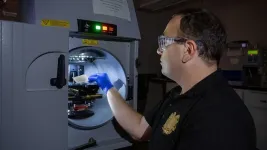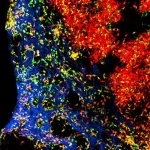(Press-News.org) Chicago — An innovative anesthesiologist-led infection prevention program helped reduce the number of surgical site infections (SSIs) in colorectal patients by 50%, the number of days in the hospital by 46%, and led to significant cost savings over a two-year period, according to research presented at the virtual American Society of Anesthesiologists’ Anesthesia Quality and Patient Safety Meeting.
“With the skyrocketing cost of medical care for patients and health care institutions, one area physicians can focus on is reducing SSIs,” said Austin Street, M.D., study author and anesthesiologist at UT Southwestern Medical Center, Dallas. “Many SSIs are preventable through well-designed, evidence-based interventions. We were very happy to reduce the SSIs in our colorectal patients by half, which also led to decreases in hospital bed days, saving the hospital and patients money, as well as freeing up beds for other patients and surgeries.”
Largely avoidable with proper infection control measures, SSIs occur either during or up to 30 days after a surgical procedure. SSIs often need to be treated with additional antibiotics, and may require interventional procedures or even re-operation. SSIs can lead to major complications, including death, as well as significantly increase the cost of care. The cost of a patient’s care increases by $20,000, on average, if they develop an SSI. According to the Centers for Disease Control and Prevention, the annual cost of SSIs to hospitals in the U.S. ranges between $3.2 billion to $10 billion a year. The SSI incidence rate in colorectal surgery is higher than many other procedures.
Prior to the intervention, the infection ratio at UT Southwestern had increased from .74 in 2018 to 3.08 in 2020, putting the program in the bottom quartile for infection rates in the country. The new infection prevention initiative leveraged the strength of the hospital’s Enhanced Recovery After Surgery (ERAS) program. An ERAS pathway is an evidence-based protocol that standardizes care to minimize surgical stress and postoperative pain, reduce complications, improve outcomes, decrease hospital length of stay and expedite recovery following elective procedures. Under the umbrella of the ERAS program, UT Southwestern’s infection prevention initiative implemented a number of interventions, each targeted at evidence-based causes of SSIs, including:
Giving oral antibiotics with the patient’s mechanical bowel preparation
Identifying the best antibiotic to use, as well as optimal timing and redosing for colorectal surgery, with the guidance of UT Southwestern’s antibiotic stewardship committee
Using chlorhexidine baths, a cleaning product that kills germs, prior to the surgery and wipes to the abdomen immediately prior to the operating room to decrease bacteria on the skin
Improving access to critical medications by storing the antibiotics directly in each operating room’s “pyxis” machines, which hold and distribute the anesthetic drugs
Requiring the surgical team and their assistants (scrub techs and residents) to change their gowns and gloves when the surgery was completed and they were about to close the wound, assuring no contamination from the surgical site got into the sterile areas of the wound
Actively warming patients both prior to and during the surgery, which has been shown to decrease the risk of wound infections
Increasing patient mobility as soon as possible after surgery, for example sitting up in a chair the day of surgery and walking in the hallways up to three times as soon as possible, which decreases the risk of infection
By implementing these infection control strategies, UT Southwestern met their goal of reducing colorectal SSIs by 50%. Additionally, the hospital saved an estimated $540,000 in total costs in 2021 and 2022, compared to 2020, and hospital bed days were reduced by 578 days (46%).
This program may serve as a useful model for other academic or major medical centers seeking to improve their SSI outcomes.
THE AMERICAN SOCIETY OF ANESTHESIOLOGISTS
Founded in 1905, the American Society of Anesthesiologists (ASA) is an educational, research and scientific society with more than 56,000 members organized to raise and maintain the standards of the medical practice of anesthesiology. ASA is committed to ensuring physician anesthesiologists evaluate and supervise the medical care of patients before, during and after surgery to provide the highest quality and safest care every patient deserves.
For more information on the field of anesthesiology, visit the American Society of Anesthesiologists online at asahq.org. To learn more about the role physician anesthesiologists play in ensuring patient safety, visit asahq.org/MadeforThisMoment. Like ASA on Facebook, follow ASALifeline on Twitter.
###
END
Imagine shrinking light down to the size of a tiny water molecule, unlocking a world of quantum possibilities. This has been a long-held dream in the realms of light science and technology. Recent advancements have brought us closer to achieving this incredible feat, as researchers from Zhejiang University have made groundbreaking progress in confining light to subnanometer scales.
Traditionally, there have been two approaches to localize light beyond its typical diffraction limit: dielectric confinement and plasmonic confinement. However, challenges such as precision fabrication and optical loss have hindered the confinement of optical fields to sub-10 nanometer (nm) or even ...
Law enforcement agencies nationwide regularly sell items that are seized in criminal investigations or are unclaimed from lost-and-found inventories. Many of these items—vehicles, jewelry, watches and electronic devices like cellphones—end up at online auction houses.
People looking for a bargain can bid on cellphones in bulk, snatching up dozens at rock bottom prices for parts or other uses. This ultimately provides revenue for the police agencies, making for a good deal for everyone involved. Or is it?
A recent study by University of Maryland security experts found that many of the phones sold ...
A team of researchers from the University of Maryland School of Maryland’s (UMSOM) Institute of Human Virology (IHV), a Center of Excellence of the Global Virus Network (GVN), published new findings that emphasize the crucial role of the urinary and genital tract microbiota in adverse pregnancy outcomes and genomic instability that originate in the womb during fetal development.
The study, published on July 17 in the Proceedings of the National Academy of Sciences of the United States of America (PNAS), established a new link between genomic instability and a protein from Mycoplasma fermentans, a kind of bacterium that commonly ...
For approximately 3,000 years, generations of green sea turtles have returned to the same seagrass meadows to eat. This was discovered by Willemien de Kock, a historical ecologist at the University of Groningen, by combining modern data with archaeological findings. Sea turtles migrate between specific breeding places and eating places throughout their lives–this much was known. But the fact that this stretches over many generations highlights the importance of protecting seagrass meadows along the coasts of North Africa. The results were published in PNAS on July 17.
When young green ...
University of Pittsburgh researchers have shown for the first time how Merkel cell polyomavirus (MCV), which causes an aggressive skin cancer called Merkel cell carcinoma, initiates DNA replication in host cells.
Published today in the journal PNAS, the study sheds light on the fundamental question of how viruses override their host cells’ carefully regulated DNA replicating system to make hundreds of new copies of themselves.
“Understanding how MCV replicates gives us really important clues about ...
Benjamin Franklin may be best known as the creator of bifocals and the lightning rod, but a group of University of Notre Dame researchers suggest he should also be known for his innovative ways of making (literal) money.
During his career, Franklin printed nearly 2,500,000 money notes for the American Colonies using what the researchers have identified as highly original techniques, as reported in a study published this week in the Proceedings of the National Academy of Sciences.
The research team, led by Khachatur ...
Research Highlights:
An analysis of more than two million adults in the U.S. found that present day heart failure risk was higher among Black adults who lived in zip codes historically impacted by redlining compared to Black adults living in non-redlined areas.
Redlining did not have the same impact on heart failure risk among white adults living in historically redlined zip codes.
Among Black adults living in historically redlined communities, approximately half of the excess risk of heart failure appeared to be explained by higher levels of socioeconomic distress.
Embargoed until 1 p.m. CT/2 p.m. ET Monday, July 17, ...
Black patients with implantable cardioverter defibrillators (ICDs) have a significantly higher burden of disease than white patients with the same device, according to a new study from University of Rochester Medical Center (URMC) cardiology researchers. Analyzing data from clinical trials conducted over a 20-year period by the Clinical Cardiovascular Research Center (CCRC) at URMC, investigators concluded that not only did Black patients with ICDs tend to be significantly younger than white patients, but they also had a higher ...
SAN ANTONIO — July 17, 2023 —A team led by Southwest Research Institute (SwRI) and The University of Texas at San Antonio (UTSA) has found that NASA’s Juno spacecraft orbiting Jupiter frequently encounters giant swirling waves at the boundary between the solar wind and Jupiter’s magnetosphere. The waves are an important process for transferring energy and mass from the solar wind, a stream of charged particles emitted by the Sun, to planetary space environments.
Jake Montgomery, a doctoral student in the joint space physics program ...
The cells of the immune system circulate mainly in the blood and migrate into the body's tissues after an inflammation. Some types of immune cells, however, are permanently located in the tissues, where they come together to form three-dimensional networks.
How do these networks form and how are they maintained? For the long-lived macrophages (phagocytes), the answer is already known: They settle in so-called niches. These are environments of connective tissue cells that supply the macrophages with nutrients and keep them ...






